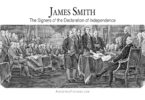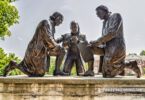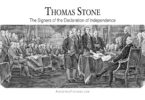Elbridge Gerry was born in 1744 in Marblehead, Massachusetts. His parents were Thomas Gerry and Elizabeth Greenleaf. His father was a merchant, as was his grandfather on his mother’s side. Elbridge was named after John Elbridge, an ancestor of his mother’s. Elbridge was one of eleven children born to his parents, and one of five to survive past childhood. Elbridge was the third of these survivors.
As a child, Elbridge was educated at home, by private tutors. After that, he entered Harvard University just prior to turning 14. He received his Bachelor's degree from Harvard in 1762 and his Master's degree from there in 1765. Upon graduation, he joined his father’s merchant business. The Gerry family was among the most wealthy merchant families in Massachusetts by the 1770s.
Elbridge was vocally opposed to the efforts of the British Parliament to tax the colonies without representation. In one of his first acts in the world of politics, Elbridge sat on a committee in Marblehead in 1770 that was attempting to enforce bans on the importation of taxed products from Great Britain. Elbridge counted among his friends at this time other well-known Revolutionary figures such as John Adams, Samuel Adams, and Mercy Otis Warren.
Elbridge was elected to the Great and General Court of the Massachusetts Bay Colony in 1772 and worked closely with Samuel Adams there to push the cause of colonial opposition to Parliamentary policies regarding the colonies. He personally set up the Committee of Correspondence in Marblehead, which was only the second one in the colony to be set up, after the one in Boston. Additionally, he tried to set up a smallpox inoculation clinic on Cat Island (along with some other prominent people from Marblehead), but poor public understanding of how smallpox was transmitted and how it could be prevented led to threats against him and his fellow clinic founders; those threats eventually led to violence on the clinic that all but destroyed it. Additional threats against the personal property of Elbridge and his fellow proprietors led them to have to step away from public politics for a bit.
In 1774, Elbridge came back on the political scene after the Boston Port Act of Great Britain prohibited any ships from bringing goods to Boston’s harbor. Because ships could not use Boston, the port at Marblehead became an attractive alternative for those still seeking to import and export goods. As one of the top merchants in town, Elbridge played an important role in making sure goods delivered to Marblehead were safely stored and taken to Boston. The colony appointed him as a representative to the Continental Congress later that year, but he declined the appointment, citing being in mourning for the recent loss of his father.
About a month after declining a position at the Continental Congress, Elbridge accepted an electoral win to the Massachusetts provincial assembly—the assembly that renamed itself the Massachusetts Provincial Congress shortly after Elbridge’s election to it. As part of this group, Elbridge was assigned to the Committee for Safety, which was responsible for ensuring the colony’s weapons and ammunition remained safely out of British hands. In fact, during the American Revolution, Elbridge used his considerable business contacts in France and Spain to keep the Continental Army supplied with munitions and other goods of all kinds. In addition, he helped move funds donated to the Revolutionary cause by Spain to the Continental Congress without British knowledge. Elbridge also dabbled in financing pirating operations on British merchant ships during the American Revolutionary War.
Elbridge was appointed to the Continental Congress again in 1776, and this time, he went and served there until 1780. While serving on the Continental Congress, he became a signer of the Declaration of Independence. In fact, he was instrumental in convincing a number of the Congressional members to approve of the document. John Adams wrote glowingly of him for his support in getting the Declaration approved because its approval required the unusual stipulation of a unanimous vote in favor of it for it to be adopted.
Elbridge was well known for his support for a limited central government, and of civilian control of the military. He opposed the existence of political parties and discouraged their formation. It was not until much later in his political career that he gave his formal support to the young Democratic-Republican Party, because of what he saw as attempts by the older Federalist Party to put too much power into the national government over the state governments.
Elbridge was well-known for his personal integrity and rejected post-Continental Congress appointments to the Massachusetts state senate and as a county judge. Instead, he served in the Massachusetts state House of Representatives, as he felt he would be more effective and useful in that role. Later, he became Vice-President of the United States under the fourth US President, James Madison.
Elbridge died in 1814, not long after visiting Joseph Nourse of the US Treasury Department. He was buried at the Congressional Cemetery in Washington, D.C., and is the only signer of the Declaration of Independence to be buried in Washington, D.C. His memorial there was made by John Frazee. In his will, he had a lot of lands to leave his wife and children, but not a lot of cash, but had managed to pay off his debts with his Vice-Presidential salary. Elbridge was sixty-eight years old when he became Vice-President, which was the oldest Vice-President to take office for more than a century until Charles Curtis in 1929.
Elbridge and his wife, Ann Thompson, together had ten children, a remarkable nine of whom survived past childhood. Some of the sons of this marriage became well-known and highly respected politicians themselves. Elbridge is commemorated in a number of ways in various places around the country, with all kinds of buildings, streets, and more being named after him. He also appears in two paintings contemporary to his life. These paintings are displayed in the Capitol Building of the United States Congress.




